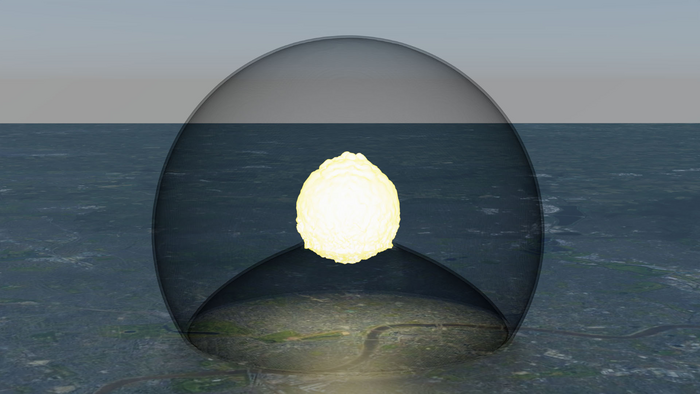Researchers modeling the effects of a nuclear missile explosion have found the safest place to survive the nuclear blast wave. Those same researchers say they hope that their work will never be put into practical use, but if one is suddenly in the area of a nuclear weapons blast wave, their findings could end up saving your life.
Incineration and radiation are deadly, but so is the blast wave
Objects and people within the immediate vicinity of a nuclear blast will most likely be incinerated by the incredible heat generated by the explosion. Likewise, radioactive “fallout” can also cause injury or death. But there is an area just outside of the immediate blast vicinity where the high-speed blast wave caused by the explosion can be just as deadly.
Those who study these types of things have known for a long time that the blast wave can kill people many kilometers away from the initial explosion, especially if that person is out in the open. But oftentimes, being inside a building or other structure is of little protection. Sure, there are certain types of buildings that stand a better chance than others. But just because the building is left standing doesn’t mean that the people inside are safe from harm.
Now, after modeling actual nuclear explosions equivalent to those produced by an ICBM warhead, a research team has not only determined the best types of buildings to seek shelter in but also found the best location within those buildings for the occupants to potentially survive the deadly nuclear blast wave.
Windows and hallways are nuclear blast wave kill zones
Initial analysis by researchers from the University of Nicosia found that concrete buildings are the most likely to survive the raw power of a nuclear blast wave. However, exactly where to hide within those buildings was not immediately evident.
“Before our study, the danger to people inside a concrete-reinforced building that withstands the blast wave was unclear,” explained one of the study’s authors, Dimitris Drikakis. “Our study shows that high airspeeds remain a considerable hazard and can still result in severe injuries or even fatalities.”
According to his team’s research, the airspeed hitting a person caught in the wrong part of the building can be the equivalent of 18 times that person’s body weight. That much instantaneous concussive force is, in many cases, more than enough to be lethal. And according to their modeling, there are certain parts of the structure where the odds of getting hit by that much force are considerably higher.
“The most dangerous critical indoor locations to avoid are the windows, the corridors, and the doors,” said study co-author Ioannis Kokkinakis. “People should stay away from these locations and immediately take shelter.”
So, if the goal is to avoid this blast as it rips through the building’s windows, doors, and corridors, where should a person stand?
“Even in the front room facing the explosion, one can be safe from the high airspeeds if positioned at the corners of the wall facing the blast,” said Kokkinakis.
You read that right. Standing in the corners of the walls nearest to the blast wave is safest, as their models showed that the wave will have the smallest impact on someone standing there and instead mostly pass right around them. Think Indiana Jones and Marion surviving with their eyes closed as the supernatural forces unleashed from the holy grail wreak havoc on the unsuspecting Nazi soldiers all around them.
Of course, the researchers add, there is likely only a few seconds between the initial blast and the resultant wave, so unless you were already standing in the corner of the front wall when an explosion goes off, you better get there fast.
Even Surviving the Initial Blast Won’t Assure Survival
The researchers behind this potentially life-saving advice, which was published in the journal Physics of Fluids, were quick to point out that even if you are lucky enough to survive the initial blast wave, there will likely be many hazards to navigate before you can reach actual safety.
“There will be increased radiation levels, unsafe buildings, damaged power and gas lines, and fires,” said Drikakis. “People should be concerned about all the above and seek immediate emergency assistance.”
The researchers once again note that they hope their findings remain theoretical and are never put to practical use. But if you find yourself within the nuclear blast wave radius when a bomb goes off, and you’re lucky enough to be inside a concrete-reinforced building that can survive the wave’s concussive force, it is sure nice to know where to stand if you don’t want to be blasted to smithereens.
Christopher Plain is a novelist, comedian, and Head Science Writer at The Debrief. Follow and connect with him on Twitter, learn about his books at plainfiction.com, or email him directly at christopher@thedebrief.org.

